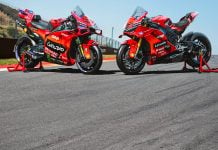FIRST PERSON/OPINION Via e-mail: Racetrack Safety and Rider Protection: After being involved in motorcycles since the 1970s and road racing in particular since the early 1990s, I have seen my share of tragic situations and safety compromises. Road racing is obviously an inherently risky sport. On a good day at a safe track, just about anything can happen, and often does. What is avoidable are some very elementary mistakes that can start with the first stroke of a pencil on a sketch pad. I don’t believe that track owners or developers make decisions that put us at risk in any way as a cost savings or compromise measure, but more so do not get enough knowledgeable input from the racing world when it comes to layout. There are certainly tracks that fall under constricted layouts due to site sizes and shapes. In some cases, it may be that the need to have the track double back on itself, or limitations of run-off make it a facility that motorcycles may not be suited for. So be it, if the facility can make a go of it with cars and karts, they will likely fill the dates anyway. Where part of the problem lies is that a new track comes about, and the hunger for motorcycle access for racing or track days drives it to be acceptable via supply and demand. It is up to any promoter, track-day organizer, sanctioning body, etc. to make an informed decision whether a facility is safe or potentially safe with the right addition of Airfence, tire barriers, etc. When there are enough red flags on inspection, there must be a point where you walk away. You cannot leave it up to individuals to decide when they show up pre-paid and ready to ride. The decision will be swayed by pressure of chasing points, time and money spent to get there, sponsors counting on performance and a show, etc., all of which might override the basic rule of self preservation. What needs to be done is to form a group of volunteers made up of a mix of people including pro riders (active and former), top club level riders, track club, sanctioning body officials, safety officials from organizations or facilities with proven success, and some all around race savvy people. It could even work out to a regional thing to keep the cost down for all. By making this organization known, track developers would certainly be interested in the input of an established organization. The group would take a trip to the facility, and do a look and see mission, possibly even under the radar with one or two people the first time during some type of event. Develop a standard check list for safety and accommodations that any rider or parent of a young rider could look at for reference and make a somewhat informed decision about going there, rather than show up and be surprised. It could include even the basics of facilities to let people know, and what is available as far as medical facilities, proximity to hospital care, power, if camping is OK, etc. That rating system could be shared by competing organizations as well. You will always have disagreement on certain tracks. I used to have people tell me how they loved racing Pocono and its F-USA layout. Others, myself included living only an hour away, did not like it for many reasons. Run-off consisted of drainage ditches with boulders in them, the track edges were undefined, bumps were epic, and you bounced onto the NASCAR front straight pointing at a wall. The management always seemed less than excited to deal with bikes as well. It took many years for the road racing community to walk away from there, and I suspect the high cost of the facility had more to do with it than safety. I personally chose to race for eight years at every LRRS event at Loudon, where walls surround much of the track, and it eventually bit me when my brakes failed. It was 100% my choice to race there, and I would never push it off on others as safe, although I always felt the lower speed were a trade off for its downside of walls. The first step in the interest of moving forward might be to make a list of tracks that are controversial and see what can be done (if anything) to improve the safety. It seems like a visit in the off-season might avoid a mad scramble weeks before an event is taking place, furthering the pressure to compromise at all levels in the interest of commitments and obligations which in the end jeopardizes the riders. I also believe there may be a level of acceptance that will differentiate a track-day-friendly layout from a race-friendly layout, but not so from Pro to club level racing. The speeds of Pro level riders requires a certain margin of error as a buffer needed when riding at the edge inches from your competitors doing the same. That is equally critical to a club racer in the respect of their potential lack of experience or ability to react to a slide or mistake that a pro can correct without the blink of an eye. That combined with the typical speed differential of bikes on course together by rider skills and/or combined classes, makes their needs possibly even more critical. The track-day crowd needs are in my opinion a little different, with average speeds being lower in most cases with exception of the experienced riders or racers attending who need to assess safety for themselves and ride accordingly. The track-day crowd could possibly compromise slightly since passing is limited and the pace is somewhat controlled. In their case, the organizer will be the key to keeping the event safe and controlled, and individuals need to be aware of the risks as always. After seeing the controversy of Topeka and NJMP this year and the diligence of the facility owners/managers to accommodate the issues the best they could with what they had, it seems only fair to people like that to give them more time to get it right. Surely there are people among our racing community that could develop a program to take an aerial view of a track layout and simulate run-off at potentially harmful corners or areas that would result in impact and project the path of a bike bumped or out of shape and make some educated analysis of potential trouble areas. Coupled with some touring in cars, and testing with qualified riders, I have no doubt some interesting results might be formed at a pretty low cost. It is probably less complicated than some fuel injection maps. You will never cover all situations, since many serious or tragic accidents result from freak circumstance, but if you manage to prevent one death or serious injury by a little pro-active work, then you’ve done your job and overall safety will have improved without most people ever knowing so. After running a team in the AMA in 2008 and getting a little closer look at the inside of the Pro rider community, I personally would volunteer to be a part of such a program. Whether it is AMA, CCS, WERA, USGPRU, AHRMA, AFM, XYZ or any others, the common theme and focus needs to be rider safety. Bob Robbins CCS#46 Allentown, Pennsylvania
More On Racetrack Safety Concerns
More On Racetrack Safety Concerns
© 2009, Roadracing World Publishing, Inc.






